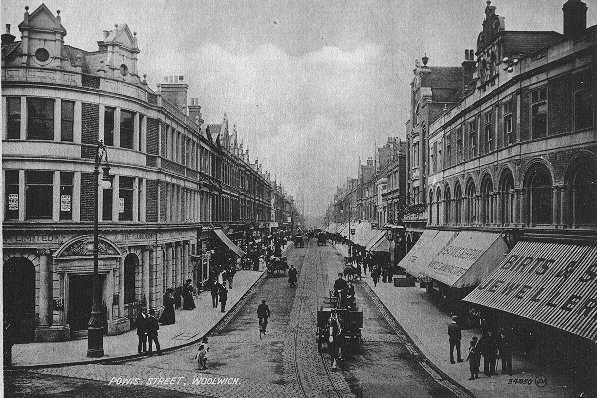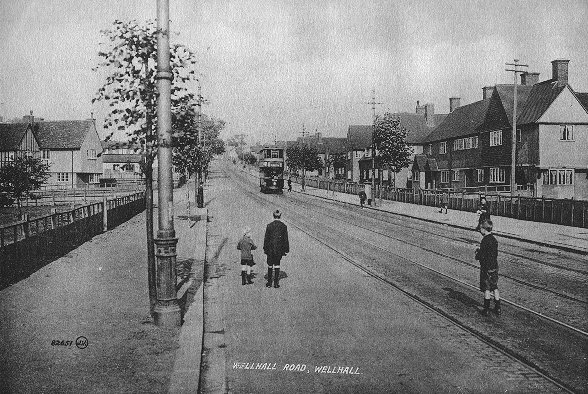a brief history

The Powis Street branch line of the Woolwich and South-East London
Tramways Company. c. 1910.
from a photograph album published by Pryce and Son. Ltd.
printers of Woolwich c. 1920

The Powis Street branch line of the Woolwich and South-East London
Tramways Company. c. 1910.
from a photograph album published by Pryce and Son. Ltd.
printers of Woolwich c. 1920
| The history of tramways in the area began with the formation of theWoolwich
& Plumstead Tramway Company in 1879. They gained power by an Act of
Parliment of 1880 to build a tramway from Hare Street Woolwich to Plumstead
Church, via Powis Street, Beresford Square, and Plumstead Road. A distance
of about 1½ miles. This company was soon taken over by the
Woolwich and South-East London Tramways Company in 1881 by local businessmen.
It ran tramcars between Beresford Square, via Beresford Street, Woolwich
High Street, Church Street, Albion Road, and Trafalgar Road, finishing
at Old Woolwich Road. End on with the tracks of the London Tramways Company.
The Woolwich Terminus was near the Southern pier of the Railway Ferry.
2,000,000 passengers had been carried on the system by 1889, the year the
LCC was inaugurated.
The trams were painted yellow and drawn by two horses, with a cock-horse (hitched alongside the other two) to help on Albion Hill. The lighting was by oil lamp and they carried 40 passengers. Fares were 1d per mile with halfpenny stages. In June 1905 the LCC bought the Woolwich Tramway under the powers of the 1870 Local Authority Act. The Powis Street line service was suspended. Electric cars were being introduced to London, starting in 1903 from Lambeth to Tooting. In 1908 the electric tram came to Woolwich displacing the horse between Beresford Square and St Nicholas Church in April, with an extension to Abbey Wood in July. Since October 1903, Bexley Urban District Council had operated an electric tram service from Gravel Hill, Bexleyheath to the Plume of Feathers, Plumstead. When the first LCC tram made its way to Abbey Wood, it ran over a short section of Bexley track from the pub to Wickham Lane. The Bexley Service soon made its way to a new terminus in Beresford Square, Woolwich. In 1910 this terminus was used by the Eltham Trams. The LCC extension to Abbey Wood connected with the Erith tramway which was constructed in 1905. There were plans to run trams up Bostal Hill and via Frazer Road and Erith to link up with the original line, but nothing became of it. Electrification continued on the London side of Woolwich. From Tunnel Avenue, Greenwich to Charlton by July 1909, and from Beresford Square to the Ferry by the following November. The London side was however not by the overhead method, but by an underground conduit system. In 1911 the electric service reached Chapel Street. You could now travel all the way from Abbey Wood to Waterloo by electric tram, except for a small section between Chapel Street and the Ferry. The horse tram was now isolated, it couldn't even get back to its depot in Lakedale road as the electric track gauge was too wide, and it could not be parked up anywhere for the night. It was hauled onto a trolley made to fit the wide gauge, and then towed back to the depot by an electric tram. By April 1914 trams began making the journey from Abbey Wood to the Victoria Embankment, these trams could operate by either the overhead or conduit system. The change over was at the Ferry where a man guided the plough (as the underground pick up was called) into the trams as they passed. |

A tram with double poles decends Well Hall Road in an all
together different time c. 1912.
from a photograph album published by Pryce
and Son. Ltd. printers of Woolwich c. 1920
| There were plans to take the trams to Well
Hall and Eltham. The Astronomer Royal at Greenwich objected by saying
that due to the hilly nature of the route the electrical discharges would
upset the delicate instruments at the observatory. He suggested the
use of twin wires and double trolley arms to maintain a closed circuit.
In July 1910 the route 44 tram went from Beresford Square to Eltham Church.
The fare from Eltham to Woolwich was 2d.
In Woolwich on Friday and Saturdays it was very crowded and at times the trams had to nose their way very carefully through the crowds in the Square. There were frequent complaints that someone would get hurt. However their was only one fatality in over 40 years. The tram crews were paid from a van which travelled to the various terminal, for the Eltham routes this was near the Arsenal Gates. A conductress jumped from her tram and ran across to pick up her pay packet and was knocked down and killed by a 75 bus. The motor omnibus came to Woolwich in 1913 with route 53 from Plumstead Common to West Hampstead in May. It was followed by Tilling's petrol electric service No 75 from Woolwich Ferry to Croydon in June. Thomas Tilling already operated a Horse bus service in the area from Blackheath to Eltham. The the 92 between Lewisham and Shooters Hill (Red Lion) in July. In December 1914 the 21 from Wood Green via Morgate to Sidcup, and the 21a to Shooters Hill, and the 99 Woolwich to Erith in 1916. In 1913 the LCC put a bill to Parliament to run a rail less tramcar (trolley) service between Eltham and Lee Green. This came to nothing, just like the tram route up Bostal Hill. Instead rails were put down Eltham Road to open as service 46 in 1920 from Lee to Eltham. The last tram route built was from Well Hall down the new Westhorn Avenue to as far as the railway, and when the railway bridge was completed on to Eltham Road, The new route was the 72 introduced in June 1932. Trolleybuses were introduced in 1935 to cover the old Bexley and Erith tram routes now numbered 96 and 98. The old trams being known as the 'Bexley Boneshakers'. On August Bank Holiday 1917 all Dartford trams were destroyed by a fire. Bexley took over the track with their own trams. With the introduction of trolleybus a six was added to the old tram number, making them 696 and 698. The 698 on the lower road service on the old Erith tramways route now went all the way to Woolwich, previously passengers had to change at Abbey Wood. Trolleybuses began to replace all those trams in North London, and in parts of SW London. The war halted the conversions. The Bexley routes were isolated. At the end of the war it was decided to replace all further trams with motor buses. So in July 1952 the Woolwich route, the last in London disappeared. The trolleybuses went in 1959. the first in London due to their isolated nature. All were gone by 1962. On the night of 5 July 1952 the last London tram of all went to the scrap yard at Penhall Road, Charlton. The withdrawals were spaced over a couple of years, and as each stage of the programme was implemented, groups of people would gather to say goodbye to the trams in their area. This gathered momentum as the withdrawals went on. The last day of all saw huge crowds out on the streets. The last tram it was planed would be 1952, the same number as the year, This was to be driven by the Mayor of Woolwich, himself an old tram driver since the days of the old horse tram. The tram before last numbered 1951 was so late due to crowds on the street that 1952 had to leave in front, 1951 arrived 46 minutes late at a quarter past one in the morning. New bus route numbers came to the area, the 53a in 1924 and the 54 in 1929. Buses to replace the trams were 177, 180, 182, 186. then supplemented by others. Some of these routes remain, some curtailed some extended. Some even with parts of their journey changed to different destinations. When tram routes were introduced it was with much celebration, when they were withdrawn, people partied. Now bus routes come and go, and most people don't even notice, Just those who find the changes convenient, or those who are inconvenienced by the change. Trams have now been reintroduced in Croydon. There is talk of other tramways in London and of new trolleybus routes. The transport of London, forever on the move. Much of the above information is contained in:
|
This page was designed and is maintained
by Toby and John King, I would accept any comments or questions See
Index Page